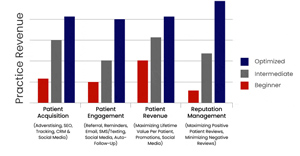Alternative Medicine Marketing Services – Costs $999/mon
Marketing your Alternative Medicine Practice requires a careful approach. You’re not just selling a service; you’re offering a path to wellness, often one that resonates with individuals seeking something different from conventional medicine. Marketing an Alternative Medicine practice requires a unique strategy that highlights the holistic, personalized, and often non-invasive approach to health.
Key differences between Alternative Medicine and Functional Medicine:
| Aspect | Alternative Medicine | Functional Medicine |
|---|---|---|
| Definition | Non-traditional, natural healing methods | Science-based, patient-centered, root cause-focused medicine |
| Focus | Healing through natural or non-invasive therapies | Personalized, comprehensive approach addressing root causes |
| Diagnosis | Less reliance on conventional diagnostics, more holistic | Conventional diagnostics + deeper functional tests |
| Treatment | Natural therapies (e.g., herbs, acupuncture) | Integrates conventional and alternative therapies |
| Training | Varies widely, may not require medical degrees | Licensed professionals with advanced training in functional medicine |
| Evidence Base | Limited scientific backing for many treatments | Evidence-based, supported by research in genetics and biology |
| Integration | Often separate from conventional medicine | Integrates with conventional medicine for comprehensive care |


Laying the Foundation: Understand Your Practice & Target Audience – Identify which services are searched by patients who are looking for alternative medical treatment.
14 types of alternative medicines potential patients look for:
1. Acupuncture – Patients look for “Licensed Acupuncturist near me “
- Description: A key component of traditional Chinese medicine (TCM), acupuncture involves inserting thin needles into specific points on the body to stimulate energy flow (qi) and promote healing. It is often used to treat pain, stress, anxiety, and various health conditions.
- Common Uses: Pain management (e.g., for chronic pain, migraines), stress reduction, improving circulation, digestive issues.
2. Homeopathy – Patients look for “homeopathic providers near me”
- Description: Homeopathy is based on the principle of “like cures like,” meaning that substances that cause symptoms in healthy people are believed to help treat similar symptoms in sick individuals. Homeopathic remedies are typically highly diluted.
- Common Uses: Allergies, asthma, digestive disorders, skin conditions, and emotional issues.
3. Herbal Medicine – Patients look for “Best herbal providers near me”
- Description: The use of plants or plant extracts to treat illnesses and promote health. Herbal medicine is one of the oldest forms of medicine and is widely used worldwide.
- Common Uses: Immune support (e.g., echinacea), stress relief (e.g., chamomile), anti-inflammatory (e.g., turmeric), digestive health (e.g., peppermint, ginger).
4. Naturopathy – Patients look for “natural health care providers near me”
- Description: Naturopathic medicine focuses on using natural therapies such as diet, exercise, and herbal treatments to support the body’s ability to heal itself. Naturopaths often emphasize prevention and the treatment of the root causes of illness.
- Common Uses: Chronic illness management, detoxification, nutrition counseling, stress management.
5. Chiropractic Care – Patients look for “best chiropractor near me”
- Description: Chiropractic treatment primarily focuses on diagnosing and treating musculoskeletal disorders, especially those related to the spine. Chiropractors use manual manipulation techniques, often called spinal adjustments, to improve function and alleviate pain.
- Common Uses: Back and neck pain, headaches, joint pain, posture correction.
6. Massage Therapy – Patients look for “massage therapy near me”
- Description: Massage therapy involves manipulating the body’s soft tissues to improve circulation, alleviate pain, and promote relaxation. It can range from gentle relaxation massages to deep tissue techniques.
- Common Uses: Muscle tension relief, stress reduction, pain management, improving flexibility.
7. Aromatherapy – Patients look for “aromatherapy massage near me”
- Description: Aromatherapy uses essential oils from plants and flowers to enhance physical and emotional well-being. The oils can be inhaled, applied to the skin, or used in diffusers.
- Common Uses: Stress relief, mood enhancement, insomnia, headache management, respiratory health.
8. Reiki – Patients look for “reiki healing near me”
- Description: Reiki is a form of energy healing that involves a practitioner placing their hands lightly on or near the body to facilitate the flow of energy and promote balance and healing. It’s based on the belief that energy flows through all living things.
- Common Uses: Stress reduction, emotional healing, pain management, promoting relaxation.
9. Ayurveda– Patients look for “ayurveda practitioner near me”
- Description: Ayurveda is a traditional system of medicine from India that seeks to balance the body, mind, and spirit through diet, herbal remedies, yoga, and lifestyle practices. It focuses on balancing the three doshas (body energies): Vata, Pitta, and Kapha.
- Common Uses: Digestive issues, stress, skin conditions, respiratory issues, mental health.
10. Hypnotherapy – Patients look for “hypnotherapy for anxiety near me” – replace with condition – like OCD “hypnotherapy for ocd near me”
- Description: Hypnotherapy uses guided relaxation and focused attention to achieve a heightened state of awareness, often referred to as a trance. It is used for therapeutic purposes to change certain behaviors or emotions.
- Common Uses: Stress reduction, smoking cessation, weight loss, anxiety management, chronic pain relief.
11. Traditional Chinese Medicine (TCM) – Patients look for “traditional chinese medicine near me”
- Description: TCM is an ancient medical system that includes acupuncture, herbal medicine, dietary therapy, and exercises like Tai Chi and Qi Gong. It focuses on restoring balance to the body’s energy (qi) and addressing the root causes of illness.
- Common Uses: Pain management, digestive health, respiratory conditions, sleep disorders, mental health.
12. Energy Healing (e.g., Quantum Healing, Pranic Healing) – Patients look for “quantum healing near me” – another example is “
- Description: Energy healing involves manipulating the body’s energy field to promote healing. Practitioners believe that disruptions in the body’s energy field lead to illness, and healing can occur by restoring balance.
- Common Uses: Stress reduction, emotional healing, chronic pain, immune support.
13. Dietary Supplements and Nutritional Therapy – Patients look for “best qhht near me”
- Description: The use of specific vitamins, minerals, herbs, or other dietary supplements to treat health conditions or support overall wellness. Nutritional therapy focuses on optimizing diet to improve health.
- Common Uses: Boosting immunity, improving digestion, managing weight, and improving overall health.
14. Detox and Cleansing Therapies – Patients look for “body detoxification near me”
- Description: These therapies aim to eliminate toxins from the body through various methods such as fasting, specific diets, or the use of herbal remedies.
- Common Uses: Digestive health, skin health, detoxification, energy boosting.
Define Your Niche:
What specific types of alternative medicine do you offer? (Acupuncture, Chiropractic, Naturopathy, Herbal Medicine, Massage Therapy, Homeopathy, etc.). You can specialize in one or multiple areas, but niche marketing can be particularly powerful. Are you focused on pain management, stress reduction, women’s health, digestive issues, etc.?
- Example: If you specialize in acupuncture for pain management, your messaging might focus on how acupuncture can help those suffering from chronic pain, fibromyalgia, or migraines. For example, “Find relief from chronic pain through acupuncture at [Your Clinic].”
Identify Your Ideal Patient:
Who are you trying to reach? Consider demographics (age, gender, location, income), psychographics (values, beliefs, lifestyle, health concerns), and their motivations for seeking alternative medicine (dissatisfaction with conventional medicine, desire for natural approaches, specific health issues).
- Example: Your ideal patient could be a 40-year-old woman dealing with stress and anxiety from a high-demand job and seeking holistic alternatives to medication. You can tailor your marketing to emphasize stress reduction treatments like acupuncture, massage therapy, or herbal supplements.
Unique Selling Proposition (USP):
What makes your practice different and better? Is it your:
- Expertise/Specialization: Years of experience, advanced training, specific techniques.
- Example: “With 15 years of experience in acupuncture and certified specialization in pain management, we provide holistic treatments tailored to your individual needs.”
- Philosophy: Holistic approach, patient-centered care, specific healing modalities.
- Example: “We believe in treating the root causes of health problems through natural therapies that nurture the mind, body, and spirit.”
- Patient Experience: Calm and welcoming environment, personalized attention, long appointment times.
- Example: “Our clinic offers an oasis of calm and personalized attention to ensure every patient receives care that is as unique as their needs.”
- Results/Outcomes: Success stories (anonymized and ethical), testimonials, specific conditions you effectively treat.
- Example: “We’ve helped over 100 patients manage their chronic pain through acupuncture. See their success stories on our website.”
Brand Identity
Develop a consistent brand that reflects your practice’s values and attracts your ideal patient. This includes your:
- Name and Logo: Professional, trustworthy, and relevant to your niche.
- Example: A name like “Serenity Acupuncture and Wellness” conveys calm and healing.
- Visuals: Website design, office decor, marketing materials – use colors, imagery, and fonts that evoke the feeling you want to create (calm, natural, energetic, etc.).
- Example: Use earth-toned colors and serene nature imagery for a peaceful, healing environment.
- Tone of Voice: How do you communicate in your marketing materials? Empathetic, informative, authoritative, gentle?
- Example: Use an empathetic tone that connects with patients on an emotional level: “We understand how chronic pain can affect your life. Let us help you find lasting relief with gentle, effective treatments.”
Building a Strong Online Presence
Professional Website (Essential):
- Informative & User-Friendly: Clearly explain your services, modalities, philosophy, and practitioner bios.
- Example: Your acupuncture page might detail what acupuncture is, how it works, and the types of conditions it can treat (e.g., back pain, stress, headaches).
- Patient-Focused Content: Address patient concerns, explain how alternative medicine can help with specific conditions, and answer frequently asked questions.
- Example: A FAQ section that answers common questions such as, “How many acupuncture sessions will I need for pain relief?”
- Content pages: Create valuable content related to alternative medicine, your niche, and health and wellness in general. This helps with SEO and positions you as an expert.
- Example: Write posts like “How Acupuncture Can Help Manage Stress” or “5 Natural Ways to Relieve Chronic Pain Without Medication.”
- Testimonials & Success Stories: With patient consent, showcase positive experiences.
- Example: Create a success story page where you share anonymous patient accounts of how your treatments helped with chronic pain, anxiety, or digestive issues.
- Online Booking/Contact Form: Make it easy for potential patients to schedule appointments or inquire.
- Example: Include an easy-to-use online booking system with options for new patient consultations and follow-up appointments.
- Mobile-Friendly and Fast Loading: Crucial for modern web browsing.
- Example: Use a mobile-optimized website design so that patients can easily navigate and book appointments from their phones.
SEO (Search Engine Optimization):
Optimize your website for search engines so people searching for alternative medicine in your area can find you. Use relevant keywords like “[your city] acupuncture,” “[your modality] practitioner,” “[condition] natural treatment.”
- Example: A search term like “Acupuncture for pain relief in San Francisco” should lead to your practice’s website.
- Content Optimization: Use long-tail keywords that reflect specific treatments or health issues.
- Example: “Best acupuncture treatment for stress relief in San Francisco” or “Holistic treatment for back pain near me.”
Google My Business (GMB):
- Claim and Optimize Your Listing: This is crucial for local SEO and appearing in Google Maps searches.
- Example: Your Google My Business profile should list services like acupuncture, massage therapy, or herbal medicine.
- Encourage Reviews: Positive Google reviews build trust and improve your local ranking. Respond to reviews (both positive and negative professionally).
- Example: “Thank you for your kind words, Sarah! We’re so glad to have helped with your chronic pain. See you soon!”
Social Media Marketing:
- Choose the Right Platforms: Focus on platforms where your ideal patients are likely to be (Facebook, Instagram, Pinterest, YouTube).
- Example: Instagram is great for visually showing your treatments, your office ambiance, and success stories.
- Run Targeted Ads: Social media ads can be very effective for reaching specific demographics and interests. Target people interested in wellness, natural health, specific health conditions, etc., in your local area.
- Example: A Facebook ad campaign targeting individuals between 35-50 years old in your area, promoting your acupuncture treatments for chronic pain relief.
Offline & Local Marketing Strategies
Networking & Referrals:
- Build Relationships with Conventional Doctors (Strategically): While some doctors may be skeptical, others are open to integrative approaches. Networking can lead to referrals, especially for complementary therapies.
- Example: Reach out to local orthopedic doctors or pain management specialists who might refer patients for acupuncture or massage therapy.
- Patient Referral Program: Encourage happy patients to refer friends and family. Offer incentives (discounts, bonuses) for successful referrals.
- Example: “Refer a friend and receive 10% off your next session! Plus, your friend will enjoy their first visit at a discounted rate.”
Community Engagement:
- Workshops & Seminars: Host free or low-cost workshops at your practice or in community spaces on relevant health topics.
- Example: “Join us for a free seminar on how herbal medicine can naturally support your immune system this winter.”
- Health Fairs & Local Events: Set up a booth at local health fairs, farmers markets, and community events. Offer free consultations, mini-treatments (e.g., chair massage), and distribute informational materials.
- Example: Offer free mini acupressure sessions at a local wellness fair to engage attendees and introduce them to your services.
Content Marketing & Education
Educational Content:
- Example: Regularly post on your website about alternative treatments for specific conditions. Topics like “How Homeopathy Treats Anxiety Naturally” or “The Benefits of Chiropractic Care for Headaches” can help you rank on search engines and establish your authority.
Email Marketing:
- Build an Email List: Offer valuable free content (e-books, guides, checklists) in exchange for email sign-ups on your website.
- Example: “Sign up for our newsletter and receive a free eBook on natural ways to relieve stress.”
Educational Videos:
- Example: Create short videos explaining your modalities, addressing common health concerns, showcasing patient testimonials, or offering quick health tips.
- Example: A YouTube video explaining how acupuncture works for stress relief and pain management.
Webinars & Online Workshops:
- Example: Host an online seminar titled “How Naturopathic Medicine Can Help You Live a Pain-Free Life” to expand your reach beyond your local area.
Patient Experience & Retention
Exceptional Patient Care:
Word-of-mouth marketing is powerful in alternative medicine. Focus on providing excellent care, creating a welcoming and comfortable environment, and building strong patient relationships.
- Example: After a treatment, send a personalized thank-you note or offer a small gift, like an herbal tea blend, to enhance the patient experience.
Loyalty Programs & Packages:
- Example: Create a loyalty program for patients who return for regular treatments. For example, “Buy 5 acupuncture treatments, get the 6th free.”
VI. Ethical & Transparent Marketing
- Truthful and Accurate Claims: Avoid making exaggerated or unsubstantiated claims about the effectiveness of your treatments. Focus on what you can realistically offer.
- Example: Instead of claiming a 100% cure rate for a condition, highlight the improvement rates or positive feedback from patients who experienced relief.
Key Takeaways for Marketing Alternative Medicine:
- Build Trust & Credibility: Transparency and ethical marketing are crucial in alternative medicine.
- Educate Your Audience: Use blogs, social media, and email to educate patients about the benefits of alternative therapies.
- Target Your Ideal Patient: Focus your efforts on attracting patients who are most likely to benefit from and appreciate your services.
- Be Patient & Consistent: Marketing takes time. Focus on long-term success and maintaining a consistent presence.
By implementing these strategies, you’ll build a strong reputation, increase your patient base, and position your practice as a trusted provider of alternative medicine. Contact Us.

